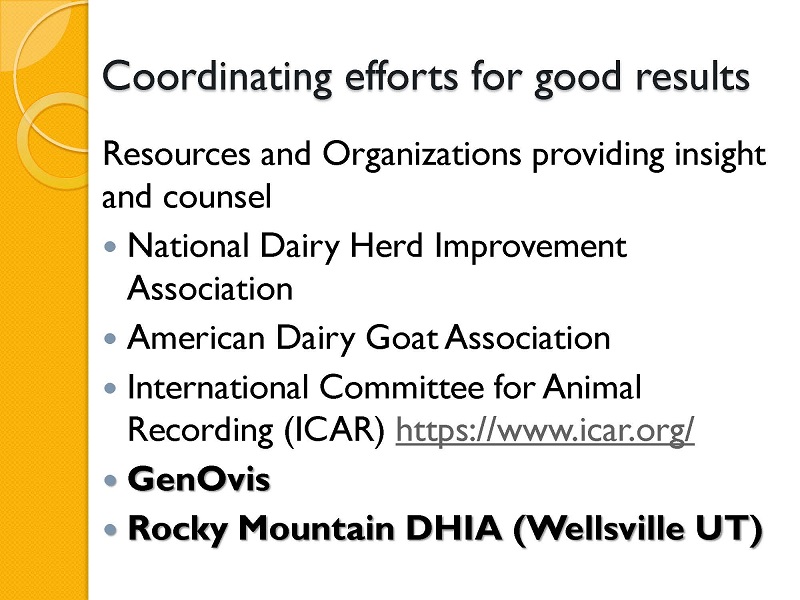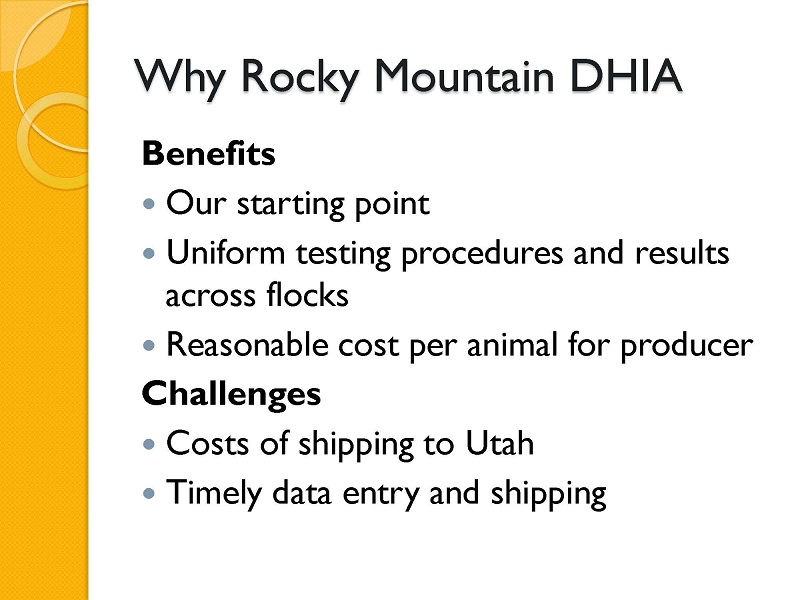Reporting
for January 1 through June 30, 2019
Report
submitted by Laurel Kieffer, Dsana
NSIIC Grant Project Manager
DSANA Narative Report
Project
performance report will consist of a
written project performance report
that includes, but is not limited
to:
a.
A comparison of timeline,
tasks, and objectives outlined in
the proposal as compared to the
actual accomplishments
b.
If the report varies from the
stated objectives or they were not
met, the reasons why established
objectives were not met
c.
Problems, delays, or adverse
conditions which will materially
affect attainment of planned project
objectives
|
Task |
Methodology |
Accomplishments to Date (new
for this timeframe are
in Italics and in blue
print) |
Challenges, Problems, Diversions |
|
Goal 1: Establish systemic approach to
gathering and analyzing
quantitative production data
that will result in
improvements in milk
production – Begin 2017 and
ongoing |
DSANA genetic improvement effort
implementation of 3-tiered
system of data collection
and estimated breeding value
generation. Recruit
producers to participate;
educate impact of EBV’s on
enterprise profitability. |
·
Three-tiered system was
fine-tuned, sent to
membership
·
4 farms representing range
of sizes and locations
identified as pilot farms:
Meadowood Farms, NY; Green
Dirt Farm, MO; Tin Willows
Sheep Dairy, OR; Forever
Young Dairy, WI signed on
and participated in the 2018
pilot. Each farm completed
the GenOvis Enrollment
forms, the animal
enrollments, and at least
three milk tests. Two of
the farms completed over 5
tests. Individuals farm
EBV’s were generated for the
four pilot farms.
·
The arrangements made with
GenOvis and Rocky Mountain
DHIA seem to be working
well. These arrangements
will be reviewed and
potentially modified as
needed before the next
milking season begins.
·
As a result of the pilot,
more specific procedural
instructions have been
developed. The uniform
animal identification
protocol seems to be working
as members become better
acquainted with the
purpose.
·
A presentation was given at
the 2018 Symposium updating
members on the Genetics
Improvement project to date
(attached). An information
and sign-up table was also
monitored throughout the
symposium with a continuous
slide show.
·
Following the DSANA
symposium in November, at
least 10 farms are now
getting ready to participate
in 2019. Three members have
already paid the $300
enrollment fee. This
enrollment fee is sufficient
to cover the GenOvis
enrollment fee and retain
some funds for DSANA to
contribute to some of the
other project costs.
·
GenOvis runs EBV analysis
weekly which allows
shepherds to have ongoing
updates to their flock
genetic projections. This
will be increasingly more
important as dairy shepherds
move toward year-round
milking.
·
Eight farms are
participating in the
Production Improvement
Project (PIP). In
combination of receiving the
EBV data from the F1 ewes
from the LaCaune semen
importation, farms are
beginning to see significant
increases in milk
production.
·
Refinements continue to be
made in the spreadsheets and
data collection.
·
Data has been gathered
through GenOvis geneticists
to estimate the heritability
of milk production and
related characteristics.
This is very exciting as,
with statistical analysis of
the raw data being generated
by the farms participating
in both the semen
importation and the PIP, we
should be able to make a
substantial and convincing
argument for farms to get on
board with the production
and genetic improvement
projects. |
This objective continues to be on
task. The greatest
challenge for this component
of the project seems to be
the time it takes for the
shepherds to gather and
enter the data required for
enrollment of the animals
and the time and expense for
ongoing milk production
testing.
We will continue to work on how to
reduce the time, increase
the efficiencies of data
entry and updating.
Primary challenges
for this period were getting
new farms enrolled, animal
data submitted, and getting
started on the milk
testing. It may seem weak,
but the weather across the
U.S.A. over the past 6
months had created
significant challenges for
our members. Milking
start-ups, challenges with
lambing, delays in field
work, etc. have all
contributed to participation
in the project being
delayed. As this is being
written, data is beginning
to come forward. |
|
Goal 2a: Create a functional and
sustainable organizational
structure for industry
leadership. |
Develop position description,
three-year organizational
work-plan, establish budget,
present centralized office
proposal to membership for
approval. Infrastructure in
place for 2019 fiscal year. |
·
The treasurer and board have
updated the financial
records; a 2019 budget has
been developed with
modifications made to the
accounting system.
·
The board met the night
before the symposium was
held in Kansas City MO. To
work on the strategic plan.
The DSANA business meeting
was also devoted to getting
membership input on
organizational direction and
focus. New committees were
formed based on the
symposium board meeting and
annual meeting discussions.
·
Strategic efforts identified
and prioritized at the
symposium face-to-face
meeting are being
implemented. Steps are being
taken to set minimum
requirements for board
involvement. One new policy
was to set a limit of 3
unexcused absences from
board meetings. This has
resulted in losing 3 board
members of the past 3
months.
·
New committees formed at the
symposium with the intent of
spreading out the leadership
load are likewise struggling
to move forward.
·
The board president and a
core of the board members
and outside volunteers are
doing outstanding work in
continuing to build the
mission and efforts of the
organization.
|
Work has not been started on creating a
centralized office or
position description.
As with most
membership-driven
organizations, DSANA also
faces challenges in keeping
people engaged in fulfilling
the ongoing organizational
needs.
Progress is slow. |
|
2b-develop reliable funding sources
for centralized office :
begin 2018 and ongoing |
Form development committee to identify
and develop funding streams
to support organizational
work plan |
·
External funding at this
time is exclusively
grant-based with exception
of symposium sponsorships.
·
The DSANA board has reviewed
the giving tiers and
enhanced the benefits
available to potential
donors.
·
Organizational membership
dues were raised slightly.
·
Symposium committee was
quite successful in
soliciting sufficient funds
to support the symposium
costs.
·
Planning has begun to fund
the Genetic Improvement
Program, specifically, the
Production Improvement
Project component.
Each member’s PIP enrollment
(US$300) has about $80 built
into it to help support the
PIP project. |
Limited progress has yet been made in
identifying external or
earned income funds
sufficient to support
organizational growth or the
continuation of the genetics
improvement project.
|
|
2c-develop Board and Committee
structure to ensure active
involvement of DSANA
membership: begin 2018 and
ongoing |
Determine what committees are needed.
Create committee purpose,
goals. Recruit members.
Develop and maintain
communications (electronic,
social media) to inform and
engage membership |
·
DSANA board president has
recruited DSANA members
beyond the board to serve on
committees. Committee
structure continues to
expand (attached).
·
Each committee is expected
to provide a written report
to the board each month.
·
Website and Facebook have
been refreshed and updated
for broader appeal to
members and for stronger
interest to non-members and
potential sponsors. Work
continues in this area.
·
Significant progress has
been made here pertaining to
membership and internet
technologies. DSANA board
has changed the online
membership and website
subscriptions to programs
that will undoubtedly serve
the organization better. The
new website goes live on
July 7, 2019.
·
The new membership platform
will allow members to
highlight their farm values,
products available and be
included in very detailed
searches from other members
as well as address “outside”
inquiries. It is hoped that
this significant change will
expand the desirability of
DSANA membership, thereby
strengthening the
organization. This new
membership platform will
also remind members of when
their membership dues and
other program dues need to
be paid and assist with
financial accounting.
·
Significant project time has
gone into revising the
website. The annual
symposium is a major focus
of the website. The new
website will give increased,
and hopefully easier to
understand and access
information and interaction
with the genetic and
production improvement
projects. The PIP platform
is being designed to
(hopefully) pique curiosity
regarding the project and
encourage participation
through not only information
pages, but also including
pictorial “how-to” clips,
worksheets, and some
testimonials. Several
modules remain to be written
and modified.
·
|
The current website design program is
under revision. Significant
improvements have been
made. There are mixed views
regarding the adequacy of
the current program in
meeting the organizational
needs. |
|
2d-develop DSANA leadership
transition plan |
Establish workgroup to draft personnel
transition and
sustainability plans. Begin
2018 |
Not yet begun.
Still in the
waiting to take shape. |
|
d.
1--Objectives established
for the next reporting period
(Progress on previous goals in
italics blue,
updates, add-ons in bold)
i.
Expand the number of farms
enrolled in Tier One and Tier Two
genetics improvement program.
Expanded from 4 pilot farms to 8
paying farms so far in 2019.
Instructions, forms, and protocols
are in place for Tier 1 and Tier 2
participation in the PIP.
ii.
Pursue
and begin statistical analysis of
initial data from the farms involved
in both the semen importation and
production improvement projects.
Look for avenues to publish results
beyond DSANA website.
iii.
Work with the sheep dairies
participating in the semen
importation project to begin the
production improvement project
enrollment process for the sires,
dams, and progeny from the
importation project.
Farms importing semen in 2017/2018
that have F1 progeny milking will be
solicited to participate in PIP. A
survey will be sent to all semen
recipients to obtain estimates of
how many F1 offspring have resulted
to date from the semen importation.
We know that the first round of A.I.
had a wide range of conception
rates. Farms are also starting to
request information on where to
purchase F1 rams and ewes. This
information will need to be gathered
and relayed to the new website. All
semen from the specific rams is
being tracked per farm. There is
potential to continue to analyze
iv.
Begin work on sheep dairy
conformation scoring.
To be
completed in next term.
v.
Continue work on the updating
of website and social media.
Continue to work on updating and
improving the website. Significant
progress made; ongoing work
required. Go to
https://dsana.org/
vi.
Expand work on funds
development efforts.
Progress made. Each member’s
payment for the estimated breeding
value service (US$300) has about $80
built into it to help support the
PIP project. All symposium
sessions will be video recorded and
offered for sale to members and
non-members not able to attend the
symposium. Plans are
underway to offer an annual bred ewe
and ram sale open only to farms
participating in PIP. Plan for
the potential sale will occur during
the next months; explore option for
joint sale with NSIP. Initial
stages for developing an
organizational funds solicitation
plan will be solidified.
vii.
Re-evaluate the need
for a centralized office and paid
staff.
Continue to explore this option.
e.
Status of compliance with any
special conditions on the use of
awarded funds
Not Applicable
f.
A progress summary suitable
for posting on the ASGC web site
The Dairy Sheep Association of North
America Genetics Improvement and
Organizational Development project
is underway with 8 farms currently
enrolled in the Production
Improvement Project. Twenty-seven
farms have purchased imported semen
through the Semen Importation
Project. Initial results from farms
participating in both the semen
importation and production
improvement projects are promising
for increasing milk production by a
substantial amount. DSANA has
purchased a new membership and
website subscription which go into
operation July 7, 2019.
http://www.dsana.org ). DSANA
annual symposium is set for November
7-10 in Idaho Falls, ID.
g.
The performance report
may be submitted by email to
stevelee@nsiic.org






















